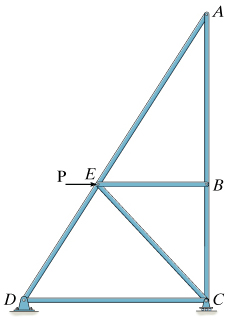Question
Zero-Force Members Learning Goal: To be able to identify zero-force members and understand their importance in truss analysis. Zero-force members occur frequently in trusses and
Zero-Force Members
Learning Goal:
To be able to identify zero-force members and understand their importance in truss analysis.
Zero-force members occur frequently in trusses and are typically used either to stabilize a truss during construction or to carry transient loads. Truss analysis can be greatly simplified by identifying and, subsequently, eliminating zero-force members.
Zero-force members
Zero-force members are truss members that carry no load under a given load configuration. Because they carry no load and their weight is negligible, compared with the loads carried by the truss, zero-force members experience no force. These members can be identified by drawing a free-body diagram of each joint and applying the conditions
? F x =0 ? F y =0
where x and y refer to the coordinate system applied at each joint.
Application of the equilibrium conditions leads to a simple method for identifying the zero-force members in planar trusses:
If the only members of an unloaded joint are two noncollinear members, both members are zero-force members.
If an unloaded joint has two collinear members and one noncollinear member only, the noncollinear member is a zero-force member.
Part A - Identifying zero-force members
Consider the truss shown below. Identify the zero-force members.

Check all that apply.
| (1) | A B |
| (2) | D E |
| (3) | C E |
| (4) | B E |
| (5) | A E |
| (6) | B C |
| (7) | C D |
D PRE A B C
Step by Step Solution
3.44 Rating (151 Votes )
There are 3 Steps involved in it
Step: 1
To check for zero force members the following points need to be considered 1 If ...
Get Instant Access to Expert-Tailored Solutions
See step-by-step solutions with expert insights and AI powered tools for academic success
Step: 2

Step: 3

Ace Your Homework with AI
Get the answers you need in no time with our AI-driven, step-by-step assistance
Get Started


